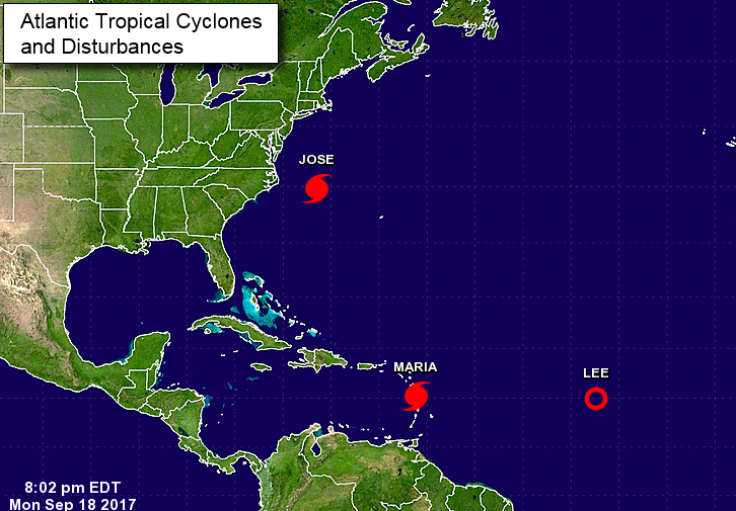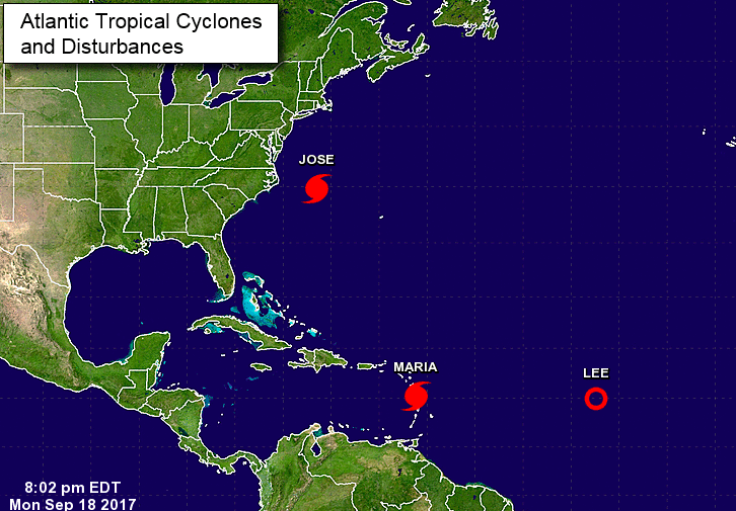Where Is Hurricane Maria Going And When Will It Hit?

Update: Sep. 20, 2017 9:07 a.m. EDT – Hurricane Maria made landfall on Puerto Rico Wednesday morning as a Category 4 storm. Maria hit near Yabucoa, bringing winds of up to 155 mph, according to AccuWeather.
The storm was expected to sweep over Puerto Rico in the coming hours, moving northwest. Maria would likely skirt by the northeastern coast of the Dominican Republic Wednesday night. The storm had the potential to directly hit Turks and Caicos as early as Friday.
“Following a direct hit on Puerto Rico, Maria is likely to remain a dangerous hurricane as it moves northwestward into Friday,” said AccuWeather hurricane expert Dan Kottlowski.
Hurricane #Maria made landfall near Yabucoa, PR, around 6:15am AST -maximum sustained winds 155 mph (250 km/h) https://t.co/4jizT4OVdn? pic.twitter.com/GPcNbjgxhN
— National Hurricane Center (@NHC_Atlantic) September 20, 2017
UPDATE: Sep. 19, 2017 1:04 p.m. EDT – Hurricane Maria continued moving west-northwest toward the Virgin Islands and Puerto Rico Tuesday afternoon as a “potentially catastrophic” storm, the National Hurricane Center said. The storm was moving at about nine mph and packed with it winds of 160 mph.
“This is going to impact all of Puerto Rico with a force and violence that we haven’t seen for several generations,” Puerto Rico Gov. Ricardo Rossello told the Associated Press. “We’re going to lose a lot of infrastructure in Puerto Rico. We’re going to have to rebuild.”
Potentially catastrophic #Hurricane #Maria moving west-northwest toward the Virgin Islands & Puerto Rico. More: https://t.co/sYVOB3gkmI pic.twitter.com/lE3wz3XcXa
— National Hurricane Center (@NHC_Atlantic) September 19, 2017
UPDATE: Sep. 19, 2017, 9:28 a.m. EDT – Hurricane Maria made landfall on Dominica Monday night as a Category 4 storm. The hurricane intensified Tuesday morning after hitting the island and was expected to head toward the Virgin Islands and Puerto Rico, areas that were already hit earlier this month by Hurricane Irma.
Maria once again strengthened back to a Category 5 storm Tuesday morning and remained about 170 miles southeast of St. Croix, Virgin Islands.
Maria could strike the Virgin Islands and Puerto as a “potentially catastrophic” storm within 24 hours, according to the Weather Channel. The National Weather Service’s office in San Juan, Puerto Rico issued a warning for “catastrophic damage” and “devastating to catastrophic flooding” Tuesday morning.
#Maria regains category 5 intensity with maximum sustained winds of 160 mph. https://t.co/tW4KeGdBFb pic.twitter.com/0Ft5Yob5hd
— National Hurricane Center (@NHC_Atlantic) September 19, 2017
Original story:
Hurricane Maria strengthened into a Category 5 storm Monday evening as it made its way toward Puerto Rico. Maria packed winds of about 160 mph as it moved through the Caribbean Sea.
The hurricane remained about 35 miles east-southeast of Dominica Monday night, moving west-northwest at about 9 mph. Dominica braced for the impact of the storm, which was expected to hit the area as soon as Monday night. It would likely be a direct hit.
“The extremely dangerous core of Maria is expected to pass over Dominica within the next hour or two,” the National Hurricane Center said at 8 p.m EDT. “Maria is likely to affect Puerto Rico as an extremely dangerous major hurricane and a hurricane warning has been issued for that island.”
#Maria is now a category 5 #hurricane with maximum sustained winds of 160 mph (260 km/h)- See the special advisory @ https://t.co/tW4KeGdBFb pic.twitter.com/1G6WMaaVEx
— National Hurricane Center (@NHC_Atlantic) September 19, 2017
Dominica opened about 146 shelters to prepare for the storm as the island was effectively “shut down,” ABC News reported.
“This is not a time for heroism,” Prime Minister Roosevelt Skerrit said at a press conference Monday. “This much water in Dominica is dangerous given our terrain and therefore persons should not wait for something to happen in order to take action.”
The storm would likely hit the Virgin Islands and Puerto Rico by Wednesday. Forecasts warned Maria could bring major damage to both places. Puerto Rico declared a state of emergency in the lead-up to the storm and evacuation orders were issued for parts of the region: the pace of the storm meant little preparations were made before a possible hit. Gov. Ricardo Rossello announced that all ports would be closed down starting Tuesday. Forecasts said Maria could bring up to 18 inches of rain to Puerto Rico.
“Now is the moment to save lives,” Rossello said of the evacuation orders.
Some 450 shelters were opened in Puerto Rico to prepare for the storm.
“Flood-prone areas must be abandoned,” said Public Security Secretary Hector Pesquero, according to ABC News. “If not, you will die.”
The storm could possibly impact the Bahamas significantly, according to some forecasts. Other islands that managed to escape a direct hit from Hurricane Irma would likely be affected severely, including Montserrat, Guadeloupe and Martinique, according to AccuWeather.
“Following Puerto Rico and a close encounter with Hispaniola, the Turks and Caicos could face a direct hit from Maria,” said AccuWeather hurricane expert Dan Kottlowski.
After moving through the Caribbean, Maria could take a variety of paths. The storm would likely move north in a way that would keep it out to sea without having any significant impacts on Florida or elsewhere in the continental United States, AccuWeather predicted.

© Copyright IBTimes 2024. All rights reserved.












